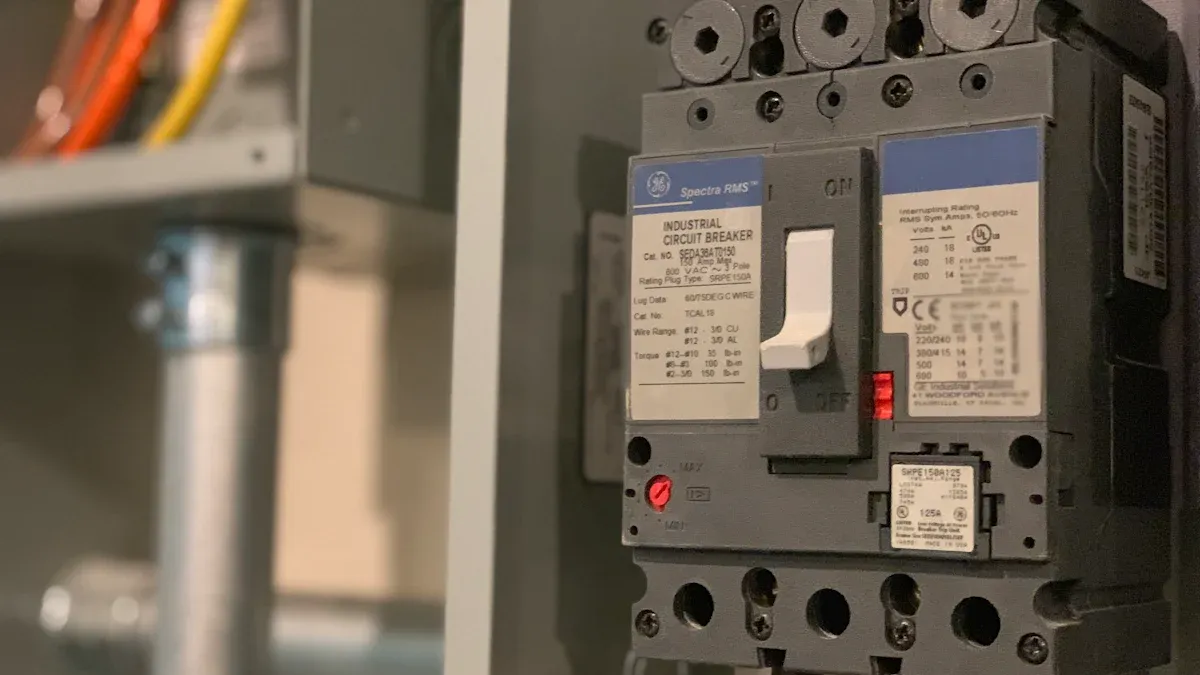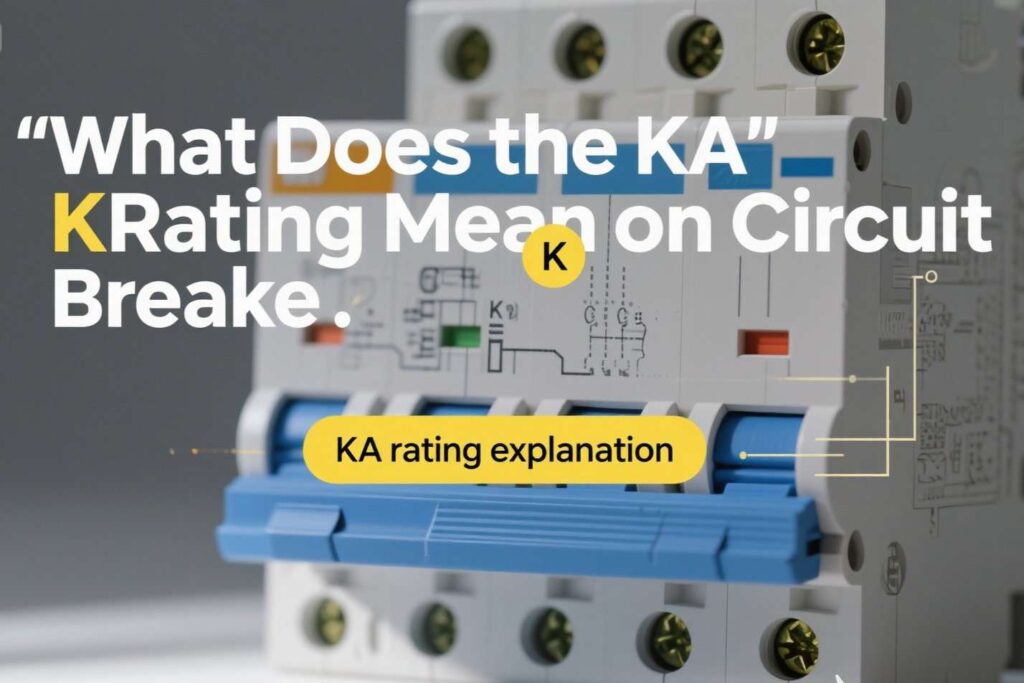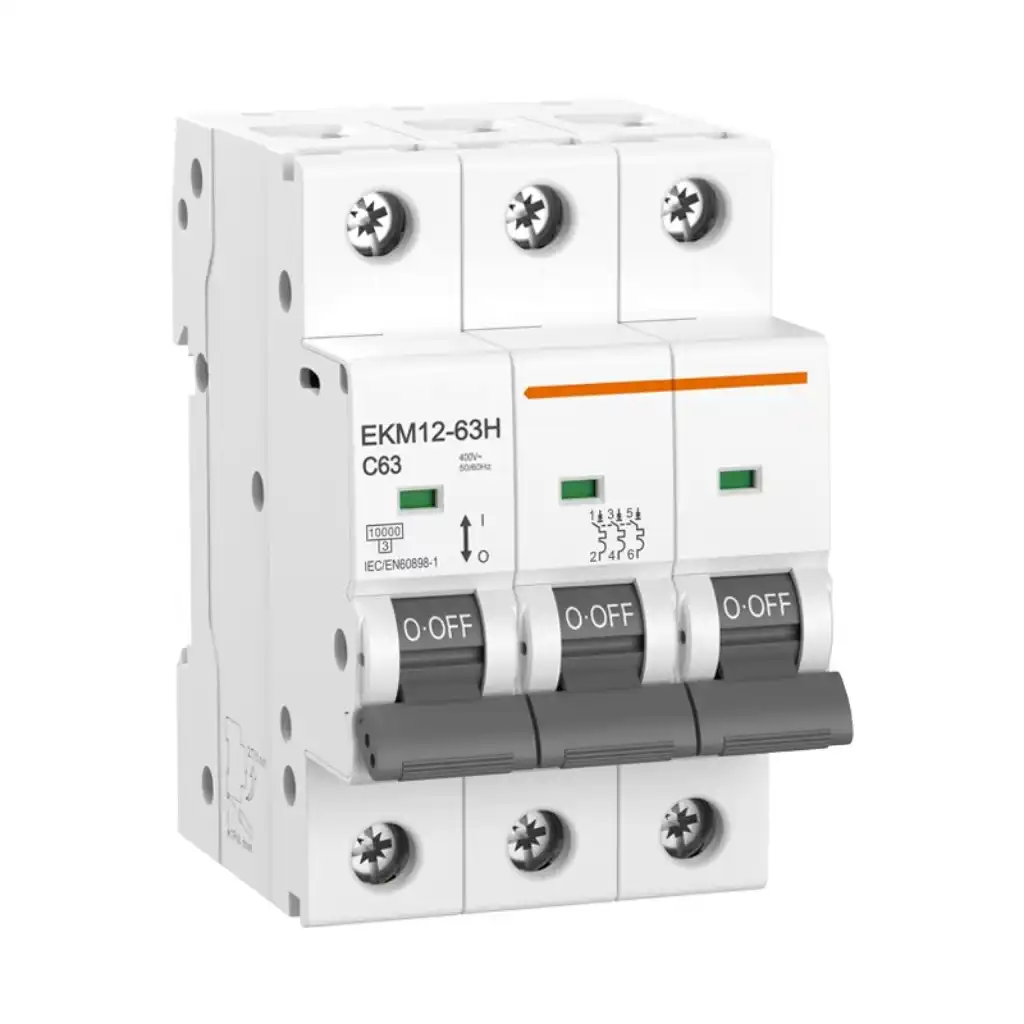The KA value of the circuit breaker indicates the highest short-circuit current the device can safely interrupt, measured in kiloamperes. Selecting the correct KA value of the circuit breaker is essential to protect people and equipment from electrical hazards.
- The KA value of the circuit breaker helps prevent electric shock, fires, and equipment damage.
- Safety regulations require using circuit breakers with the appropriate KA value of the circuit breaker to limit fault currents and reduce risks.
- Manufacturers test the KA value of the circuit breaker to ensure it can handle the maximum fault current in a system.
Key Takeaways
- The KA rating tells us the most short-circuit current a breaker can safely stop. This helps protect people and equipment from harm. Picking a breaker with the right KA rating stops fires, shocks, and damage to equipment. Always make sure the breaker’s KA rating is as high as or higher than the system’s biggest fault current. This keeps things safe and follows the rules. Checking often and labeling things right helps keep electrical systems safe. It also helps meet safety codes like the NEC. Ask experts and use good math to pick the right KA rating for each system.
The KA Value of the Circuit Breaker
What KA Means
The KA value of the circuit breaker shows the biggest short-circuit current it can safely stop. “kA” means kiloamperes, or thousands of amperes. This number tells how much fault current the breaker can handle before it might break. The KA value of the circuit breaker is also called breaking capacity. It helps people know if the breaker will work safely during a big electrical problem.
Note: The KA value of the circuit breaker is printed on the device label. This number is very important for safety. It must match what the electrical system needs.
The table below explains some main words about the KA value:
| Term/Concept | Definition/Explanation |
|---|---|
| kA (kiloampere) | Unit of electric current equal to 1,000 amperes; shows the biggest short-circuit current a breaker can safely stop. |
| Breaking Capacity | Also called kA rating; the highest short-circuit current the breaker can stop without damage. |
| Symmetrical Breaking Capacity | Maximum RMS AC part of short circuit current breaker can stop when contacts open. |
| Asymmetrical Breaking Capacity | RMS value with AC and DC parts at breaker contact opening; higher than symmetrical breaking current. |
| Making Capacity | Biggest current the breaker can carry when closed, including short circuits with closed contacts. |
| Short-Circuit Current Rating (SCCR) | Highest RMS current breaker can carry without outside damage, usually in kA. |
| Short Circuit Withstand Capacity | Biggest instant current breaker can take on a short circuit without failing; also called ultimate breaking capacity (kA). |
| Importance of kA Rating | Makes sure breaker can safely stop fault currents; wrong rating can cause damage, fire, or deadly accidents. |
Breaking Capacity and Icu
Breaking capacity means the most short-circuit current a breaker can stop without getting hurt. Experts also call this number Icu, which stands for “ultimate short-circuit breaking capacity.” Icu shows the highest fault current the breaker can stop one time, during tests. If a breaker faces a fault higher than its Icu, it might break and cause danger.
There is another number called Ics, or “service short-circuit breaking capacity.” Ics tells how much current the breaker can stop and still work again after the fault. Usually, Ics is a part of Icu. For example, if Icu is 10 kA and Ics is 7.5 kA, the breaker can safely stop 7.5 kA many times, but can only stop 10 kA once.
Modern circuit breakers use special designs to reach high breaking capacities. Fast vacuum circuit breakers (FVCBs) can open in less than 2 milliseconds. They use controlled switching to pick the right time to break the current. The contact design and speed help the breaker stop big fault currents fast and safely.
Typical KA Ratings
The KA value of the circuit breaker depends on where it is used. Home circuit breakers usually have lower ratings than those in factories or big buildings. The table below shows common ranges:
| Breaker Type | Typical Continuous Current Range | Typical Voltage Range | Typical Short-Circuit Current Rating (kA) |
|---|---|---|---|
| Residential | 15 A – 225 A | 120 V, 127 V, 120/240 V | 10 kA – 42 kA |
| Commercial/Industrial | 125 A – 3000 A | 120 V – 600 V | 10 kA – 200 kA |
Most homes use breakers rated around 10 kA to 15 kA. Commercial buildings often need breakers rated 20 kA or more. Big factories may use breakers with ratings up to 200 kA. Picking the right KA value of the circuit breaker keeps people and equipment safe from dangerous faults.
⚡ Tip: Always check the biggest possible fault current at the place where you install the breaker. Pick a breaker with a KA value that is the same or higher than this number.
Why KA Rating Matters
Safety
Picking the right KA rating for a circuit breaker is very important for safety. If someone uses a breaker with a KA value that is too low, it might not stop a big fault current. This can cause fire, electric shock, or even explosions. Sometimes, low KA rated breakers do not trip fast because of sticky grease or rusty parts. These problems can make the breaker slow, from 5 cycles up to 30 cycles. When this happens, arc flash energy can go from 3.5 cal/cm² up to 20.4 cal/cm². This big jump in energy can give workers bad burns or even kill them, especially if their PPE is for lower energy. Doing regular checks and using the right KA ratings help stop these dangers.
A real story from a biogas power plant showed that using fast relays and good breaker settings can lower arc flash energy. By making the energy drop from 6.6 cal/cm² to a safer number, workers only needed lighter PPE. This story shows that the right KA rating and quick breaker action keep people safe from bad injuries.
⚠️ Note: The Authority Having Jurisdiction (AHJ) checks electrical systems to see if they follow safety rules. The AHJ looks at breaker ratings and system plans before letting power turn on. This helps stop dangers like arc flash and makes sure the KA value of the circuit breaker fits the system.
Equipment Protection
The KA rating also keeps electrical equipment safe. When a fault happens, a breaker with the right KA value can stop the current before it hurts wires, panels, or machines. If the breaker has a KA rating that is too low, it might break during a fault. This can let too much current flow, which can ruin equipment and cost a lot to fix.
To keep equipment safe, engineers first get fault current numbers from the utility. They use math or computer programs to find the biggest fault current at each spot in the system. They add extra safety to cover future changes or things they do not know. The KA value of the circuit breaker must be the same or higher than the fault current they find. This careful work keeps equipment safe and stops long downtime.
- The right KA ratings let breakers stop high fault currents, which stops fires and damage.
- If the KA rating is too low, breakers can fail, and too much current can hurt appliances and wires.
- Engineers must figure out the fault current and pick the right KA rating for each job.
- Good KA ratings mean less downtime, lower repair bills, and better safety for all electrical parts.
- Regular checks and updates keep the system safe as it grows or changes.
Compliance
Electrical codes and rules say you must use circuit breakers with the right KA ratings. The National Electrical Code (NEC) 110.9 says all equipment must have a breaking rating high enough for the fault current at its spot. NEC 110.10 also says the short-circuit current rating (SCCR) must match or be higher than the fault current. These rules make sure breakers and panels can handle faults without breaking.
- NEC 110.9: Equipment must have a breaking rating for the fault current.
- NEC 110.10: Equipment must have an SCCR that matches or is higher than the fault current.
- UL standards, like UL 508A, set rules for industrial panels and help raise equipment ratings.
- All breakers in a panel must meet or be higher than the panel’s KA rating.
- If any device has a lower SCCR, it is the weak spot and must be changed or upgraded.
Manufacturers often make equipment to handle most fault current cases in their field. Sometimes, they use higher-rated parts or add devices to limit current. This planning helps meet safety rules and saves money. Following these rules keeps people, equipment, and buildings safe from electrical dangers.
Interpreting KA Ratings
Common Values (6kA, 10kA, etc.)
Circuit breakers have different KA ratings for different jobs. Most homes use breakers with a 6kA rating. This means the breaker can stop up to 6,000 amperes during a short circuit. Commercial buildings often use 10kA breakers. Factories sometimes need even higher ratings. The KA value of the circuit breaker must match the biggest fault current in the system.
The table below shows where people use different KA ratings:
| Application Area | Typical Current Rating(s) | Typical Breaking Capacity (kA) |
|---|---|---|
| Residential (Lighting and Outlets) | 6A, 10A, 16A | 6kA |
| Residential (Heavy Appliances) | 20A, 25A | 6kA |
| Commercial (General Use) | 16A, 20A, 25A | 10kA |
| Commercial (Heavy Machinery) | 32A, 40A | 10kA |
| Industrial (Motors, Transformers) | 40A, 50A, 63A | 15kA |
| Specialized Equipment | Varies | 6kA, 10kA, or 15kA |
A Miniature Circuit Breaker (MCB) with a 10kA rating can stop up to 10,000 amperes. Picking a breaker with a KA rating higher than the possible fault current keeps things safe.
How to Read the Label
Manufacturers put important information on the circuit breaker label. The label shows the brand, serial number, and the highest amperage, like 5KA or 10KA. It also lists the voltage, such as 110 VAC or 220 VAC, and the frequency, like 50 or 60 Hz. Some labels show the trip curve, like “C25.” Here, “C” is the trip curve and “25” is the rated current in amps. The KA rating, such as “6000,” tells the most short-circuit current the breaker can stop. Reading these details helps people pick the right breaker.
The KA value of the circuit breaker is usually easy to see on the label. For example, a label might say “10KAIC.” This means the breaker can stop up to 10,000 amps.
Misconceptions
Some people think equipment should never go over the utility’s short-circuit current. But the interrupting rating (kA rating) shows the most current a breaker can safely stop during a short circuit. Wires in homes cannot handle the high currents found in factories. The kA rating helps people know what each breaker can do.
Some think a higher KA rating always gives better protection. But the right KA rating depends on what the system needs. Using a breaker with a much higher rating than needed does not make things safer and can cost more.
Choosing the Right KA Value

Assessing System Needs
To choose the correct KA rating, engineers first study the electrical system. They look at the system voltage, transformer size, and wire length. They also check how motors add to fault current. Power system studies and arc flash studies help find the highest short-circuit current. Engineers use special software and formulas to model the system and test different fault cases. They keep records of all KA ratings and update them when the system changes. Training and expert advice help teams understand these needs. New tools, like AI-based prediction, can make these checks faster and more accurate.
Selection Steps
Engineers follow clear steps to select the right KA rating:
- Find the maximum fault current at the breaker’s location. Use system voltage, transformer details, and wire data.
- Use formulas or software to calculate the fault current. For example, for a single-phase transformer, multiply voltage by current, then divide by 1,000 to get kVA.
- For three-phase systems, multiply voltage by current by 1.732, then divide by 1,000.
- Adjust for starting current by multiplying by 1.25 or dividing by a power factor, usually 0.8.
- Pick a breaker with a KA rating equal to or higher than the calculated fault current.
- Choose the next standard size if the number falls between two ratings.
🛠️ Tip: Always select a breaker with a KA rating that matches or exceeds the system’s needs. This keeps people and equipment safe.
Practical Tips
For homes, most breakers with a 6kA or 10kA rating work well. In commercial buildings, higher ratings like 15kA or 20kA may be needed. Engineers should check the utility’s fault current data and use calculation tools for accuracy. When in doubt, they should ask a licensed electrician or electrical engineer. The KA value of the circuit breaker must always meet or exceed the highest possible fault current at the installation point. Regular checks and updates help keep the system safe as it grows or changes.
Picking the right KA rating for circuit breakers keeps people and equipment safe. The correct KA value also helps follow rules like NEC, OSHA, and NFPA 70E. Checking systems often, making good models, and using clear labels stop shocks, fires, and arc flashes. The table below shows how KA ratings help with safety and following rules:
| Factor | Impact on Safety and Compliance |
|---|---|
| Proper KA Rating | Lowers arc flash risk, makes sure PPE is right |
| Accurate Labeling | Helps with safe work and use |
| Routine Inspections | Stops equipment problems and legal trouble |
If you are not sure, ask a licensed expert to help you choose.
FAQ
What does the KA rating on a circuit breaker mean?
The KA rating shows the highest short-circuit current the breaker can safely stop. This number helps people know if the breaker will protect the system during a fault.
What happens if someone uses a breaker with a lower KA rating than needed?
A breaker with a low KA rating may fail during a big fault. This failure can cause fires, damage equipment, or hurt people.
What is the difference between KA and ampere ratings on a breaker?
The ampere rating shows the normal current the breaker can carry. The KA rating shows the biggest fault current it can safely interrupt.
What should someone check before choosing a KA rating?
People should check the maximum possible fault current at the installation point. The KA rating must meet or exceed this value.
What does “Icu” mean on a circuit breaker label?
“Icu” stands for “ultimate short-circuit breaking capacity.” It shows the highest fault current the breaker can stop one time during a test.
The following information may be of interest to you
What size surge protector for 200 amp service
Rated value of molded case circuit breaker
Leading Manufacturers of Miniature Circuit Breakers in 2025
What is a DIN rail mounted miniature circuit breaker and how does it work
Step-by-Step Guide to Replacing Your Circuit Breaker Panel




